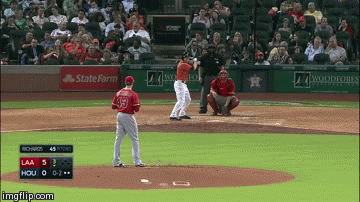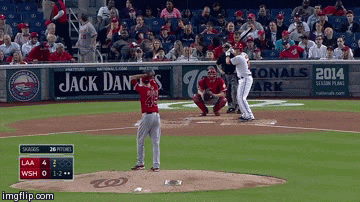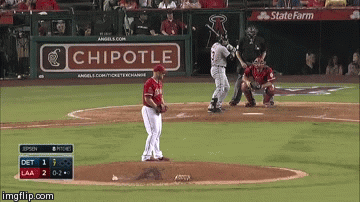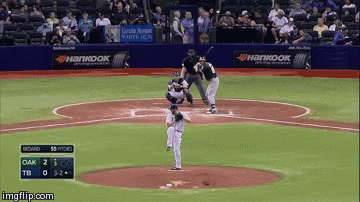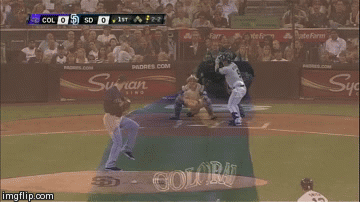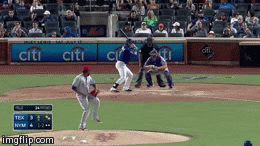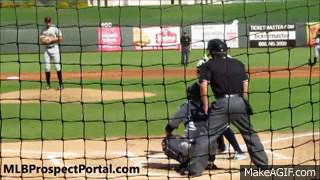Pitch Grades vs. Relative Pitch Grades
When deciding on the grade for a pitcher’s breaking pitch, a scout relies on the pitch’s velocity and movement (although command can be factored in as well). These factors are combined into a single number on a scale from 20-80, with major league average as a 50 and a standard deviation recorded at 10.
Clayton Kershaw’s curveball has long been regarded as one of the best in the business, yet by my systematic calculation factoring in velocity, horizontal movement, and vertical movement, his curveball rated among the bottom third of curveballs. Its below-average velocity and below-average horizontal movement held it back despite its above-average vertical movement. While I was pondering this conundrum, I remembered another fact–Kershaw’s fastball happens to have a lot of rise. What if movement was recorded by the difference between the pitcher’s fastball movement and the breaking ball movement instead of the breaking ball’s movement compared to an arbitrary point? I was about to find out.
(This paragraph is solely methodology, so skip it if you wish.) Using Baseball Prospectus’ excellent pitch f/x leaderboard, I selected all pitchers who threw at least 200 four-seam fastballs and at least 100 curveballs in 2014. A breaking pitch’s horizontal and vertical movement was recorded as the difference between the pitch’s raw movement and the pitcher’s four-seam fastball’s movement. I calculated the z-scores for the curveball’s velocity and the z score for the combination of the z scores of the curveball’s relative movements. (I gave a 150% weight to vertical movement over horizontal movement). Then, I combined the z scores of the velocity and combined relative movement to calculate a relative pitch score. (I gave a 150% weight to combined relative movement over velocity). Finally, I calculated a scouting grade on the 20-80 scale based off the relative pitch score. Below is a table showing my results.
While I may not have solved the difference of evaluation among Kershaw’s curveball, the relative scouting grade at least opens discussion on how movement and velocity of pitches should be evaluated. Is it better for a breaking pitch to be faster, or is it better to create a wider difference in velocity between the fastball and breaking ball? Is it better for a pitcher’s breaking ball movement to be as different from the fastball as possible, or do some similarities create greater deception because a hitter can’t recognize the pitch earlier?
| Player | CU Vel | CU H Mov | CU V Mov | Rel SG | Unadj SG |
| Garrett Richards | 79.68 | 5.85 | -12.33 | 76.26 | 71.63 |
| Sonny Gray | 82.45 | 9.21 | -5.44 | 76.09 | 67.11 |
| Justin Grimm | 81.63 | 7.15 | -6.92 | 72.63 | 64.67 |
| Blaine Hardy | 78.62 | 1.55 | -9.74 | 71.28 | 53 |
| Adam Wainwright | 75.37 | 9.34 | -9.23 | 69.59 | 60.71 |
| John Axford | 78.77 | 4.37 | -9.81 | 69.07 | 59.61 |
| Carlos Torres | 79.9 | 6.43 | -9.09 | 68.1 | 64.79 |
| Robbie Erlin | 74.28 | 0.81 | -10.64 | 68.01 | 43.53 |
| Felix Hernandez | 80.97 | 7.25 | -8.16 | 67.84 | 66.62 |
| Yu Darvish | 78.16 | 8.5 | -7.46 | 67.83 | 60.8 |
| Yordano Ventura | 83.76 | 2.28 | -5.63 | 65.12 | 55.81 |
| Clay Buchholz | 78.25 | 8.88 | -7.36 | 64.52 | 61.56 |
| Brandon Workman | 77.09 | 4.68 | -9.35 | 64.24 | 55.08 |
| Tyler Skaggs | 77.58 | 6.64 | -8.92 | 63.97 | 59.31 |
| Jake Arrieta | 80.12 | 5.81 | -9.46 | 63.55 | 64.97 |
| Juan Gutierrez | 81.1 | 6.16 | -6.77 | 62.94 | 60.89 |
| Kevin Jepsen | 84.52 | 3.9 | -6.89 | 62.68 | 64.44 |
| James Paxton | 82.54 | 0.39 | -2.69 | 62.49 | 41.05 |
| Chris Tillman | 76.22 | 3.31 | -10.43 | 62.3 | 52.94 |
| Craig Kimbrel | 86.3 | 4.84 | -5.95 | 62.14 | 68.18 |
| Adam Warren | 81.94 | 4.9 | -6.62 | 61.45 | 59.77 |
| Dellin Betances | 83.85 | 7.04 | -3.79 | 61.29 | 61.37 |
| Edinson Volquez | 80.67 | 5.95 | -7.3 | 60.89 | 60.83 |
| Wade Davis | 85.56 | 3.29 | -4.69 | 60.28 | 59.75 |
| Tom Wilhelmsen | 78.85 | 6.01 | -7.58 | 60.26 | 57.4 |
| Trevor May | 77.76 | 7.56 | -6.23 | 59.46 | 54.56 |
| Cody Allen | 86.88 | 5.09 | -3.71 | 59.12 | 64.13 |
| Tyler Thornburg | 78.45 | 2.83 | -7.21 | 59.01 | 48.63 |
| Casey Janssen | 74.81 | 9.84 | -5.38 | 58.98 | 50.23 |
| Trevor Bauer | 79.18 | 5.17 | -8.33 | 58.51 | 58.36 |
| Brad Peacock | 77.37 | 5.91 | -7.39 | 57.85 | 53.18 |
| Brett Oberholtzer | 79.73 | 1.73 | -3.22 | 57.83 | 38.69 |
| Cole Hamels | 79.01 | 3.23 | -6.2 | 57.81 | 48.13 |
| Josh Tomlin | 76.76 | 4.39 | -7.46 | 56.34 | 48.65 |
| Drew Pomeranz | 81.77 | 4.9 | -7.41 | 56.24 | 61.47 |
| Gio Gonzalez | 78.4 | 5.35 | -8.64 | 56.18 | 57.73 |
| Andre Rienzo | 79.26 | 6.3 | -6.52 | 55.97 | 56.17 |
| Scott Atchison | 80.83 | 4.81 | -8.52 | 55.78 | 62 |
| Scott Kazmir | 77.03 | 0.12 | -3.35 | 55.77 | 29.19 |
| Ian Kennedy | 78.23 | 6.26 | -9.1 | 55.71 | 60.51 |
| Nick Tepesch | 78.82 | 5.36 | -8 | 55.71 | 57.04 |
| Cory Rasmus | 76.65 | 5.44 | -7.84 | 55.67 | 51.66 |
| Tom Koehler | 79.92 | 5.1 | -8.64 | 55.42 | 60.79 |
| Marco Estrada | 77.92 | 4.66 | -6.27 | 55.31 | 48.81 |
| Mike Fiers | 72.93 | 3.7 | -11.31 | 55.29 | 48.33 |
| Odrisamer Despaigne | 76.43 | 8.24 | -7.25 | 55.08 | 55.59 |
| Francisco Rodriguez | 76.96 | 7.14 | -6.73 | 54.97 | 53.1 |
| Anthony Ranaudo | 78.16 | 4.35 | -7.93 | 54.82 | 53.13 |
| Stephen Strasburg | 80.69 | 7.59 | -7.28 | 54.74 | 64.35 |
| Mike Minor | 81.66 | 0.98 | -3.82 | 54.69 | 43.24 |
| Yovani Gallardo | 79.95 | 4.01 | -6.75 | 54.68 | 53.49 |
| Jeremy Hellickson | 76.7 | 7.51 | -9.53 | 54.53 | 60.71 |
| Justin Verlander | 79.98 | 4.97 | -6.45 | 54.29 | 54.83 |
| Dillon Gee | 74.91 | 8.15 | -7.75 | 54.19 | 53.13 |
| J.A. Happ | 78.27 | 2.13 | -4.71 | 53.89 | 40.06 |
| Kevin Quackenbush | 77.17 | 5.05 | -7.88 | 53.7 | 52.15 |
| Roenis Elias | 79.81 | 7.16 | -6.09 | 53.3 | 58.18 |
| Marcus Stroman | 83.34 | 8.96 | -2.3 | 53.27 | 60.33 |
| Jason Vargas | 75.68 | 1.63 | -5.08 | 53.05 | 33.84 |
| Clayton Kershaw | 74.61 | 2.35 | -8.93 | 52.85 | 43.08 |
| Collin McHugh | 73.68 | 8.26 | -9 | 52.55 | 53.77 |
| David Phelps | 80.72 | 2.7 | -5.06 | 52.51 | 48.01 |
| Tommy Hunter | 83.55 | 6.01 | -3.14 | 52.48 | 56.72 |
| Wesley Wright | 79.8 | 3.86 | -4.65 | 52.48 | 47.24 |
| Miles Mikolas | 75.4 | 6.22 | -9.7 | 52.36 | 55.32 |
| Javy Guerra | 77.99 | 3.47 | -7.42 | 52.2 | 49.48 |
| Jason Hammel | 77.19 | 6.3 | -7.76 | 52.1 | 54.57 |
| Vic Black | 82.68 | 3.57 | -3.91 | 51.95 | 51.46 |
| Phil Coke | 80.48 | 0.98 | -3.37 | 51.9 | 39.25 |
| Nick Martinez | 76.92 | 3.84 | -8.05 | 51.86 | 49.41 |
| Jordan Zimmermann | 79.71 | 5.65 | -6.73 | 51.77 | 56.4 |
| Phil Hughes | 77.22 | 6.62 | -7.84 | 51.53 | 55.54 |
| Zack Greinke | 72.88 | 6.58 | -7.08 | 51.41 | 43.17 |
| Colby Lewis | 77.7 | 6.12 | -5.81 | 50.97 | 50.21 |
| Joe Kelly | 79.88 | 6.94 | -8.44 | 50.7 | 64.12 |
| David Price | 80.37 | 2.84 | -1.58 | 50.68 | 38.24 |
| Tim Lincecum | 75.63 | 3.81 | -8.37 | 50.62 | 47.15 |
| Junichi Tazawa | 76.12 | 6.87 | -8.14 | 50.61 | 54.27 |
| Matt Garza | 75.25 | 4.66 | -8.62 | 50.4 | 48.74 |
| Jake Peavy | 80.56 | 2.49 | -1.91 | 50.39 | 38.81 |
| Joba Chamberlain | 79.74 | 5.1 | -6.03 | 50.25 | 53.43 |
| John Lackey | 79.16 | 5.54 | -5.39 | 50.13 | 51.3 |
| Grant Balfour | 82.74 | 2.44 | -1.31 | 50.07 | 42.27 |
| Wei-Yin Chen | 74.9 | 3.11 | -6 | 50 | 37.62 |
| Danny Duffy | 78.22 | 3.8 | -6.76 | 49.95 | 48.98 |
| Michael Wacha | 75.4 | 4.99 | -6.15 | 49.88 | 43.24 |
| Zack Wheeler | 79.61 | 6.2 | -8.2 | 49.75 | 61.25 |
| Anthony Varvaro | 80.73 | 4.14 | -5.43 | 49.68 | 52.11 |
| Shelby Miller | 77.76 | 7.65 | -5.21 | 49.51 | 52.05 |
| Edwin Jackson | 79.94 | 1.31 | -3.97 | 49.41 | 40.28 |
| Miguel Gonzalez | 77.47 | 5.77 | -6.3 | 49.39 | 50.22 |
| Anibal Sanchez | 79.85 | 3.27 | -3.53 | 49.35 | 43.11 |
| Jesse Hahn | 74.64 | 8.63 | -8.05 | 49.33 | 54.32 |
| Brandon McCarthy | 82.24 | 5.96 | -4.24 | 49 | 56.44 |
| Mat Latos | 76.95 | 3.64 | -4.84 | 48.99 | 40.53 |
| Tanner Roark | 74.25 | 6.13 | -9.04 | 48.69 | 50.65 |
| Vance Worley | 77.87 | 6.06 | -5.44 | 48.53 | 49.5 |
| J.J. Hoover | 75.78 | 6.82 | -6.21 | 48.49 | 48.24 |
| Jose Fernandez | 83.56 | 8.96 | -1.82 | 48.41 | 59.58 |
| Felix Doubront | 75.43 | 2.87 | -8.77 | 48.33 | 45.72 |
| Jordan Lyles | 81.77 | 2.16 | -3.92 | 48.31 | 46.3 |
| Santiago Casilla | 82.01 | 4.48 | -5.46 | 48.18 | 55.95 |
| Kevin Correia | 79.47 | 6.02 | -3.46 | 48.15 | 47.94 |
| Erik Bedard | 74.86 | 4.96 | -6.51 | 48.07 | 42.86 |
| James Shields | 80.39 | 3.11 | -4.08 | 47.79 | 45.51 |
| Gerrit Cole | 84.65 | 6.34 | -3.47 | 47.79 | 60.91 |
| Chase Anderson | 77.79 | 4.59 | -7.32 | 47.24 | 51.15 |
| Rick Porcello | 78.15 | 7.45 | -5.93 | 46.98 | 54.45 |
| Travis Wood | 72.92 | 1.78 | -6.47 | 46.64 | 31.32 |
| Samuel Deduno | 81.59 | 6 | -5.39 | 46.63 | 58.04 |
| Johnny Cueto | 81.53 | 2.02 | -1.73 | 45.52 | 39.62 |
| David Buchanan | 77.95 | 4.31 | -8.22 | 45.48 | 53.31 |
| Ian Krol | 79.05 | 5.17 | -4.38 | 45.11 | 47.56 |
| Erasmo Ramirez | 80.4 | 3.22 | -1.79 | 45.05 | 39.68 |
| Charlie Morton | 78.99 | 9.72 | -7.1 | 45.02 | 64.43 |
| Matt Cain | 78.2 | 7.49 | -5.26 | 44.99 | 52.88 |
| Jose Quintana | 80.94 | 2.22 | -2.39 | 44.96 | 40.41 |
| A.J. Burnett | 82.4 | 4.23 | -5.31 | 44.89 | 55.94 |
| Vidal Nuno | 77.29 | 4.84 | -5.16 | 44.68 | 44.76 |
| Daisuke Matsuzaka | 75.37 | 8.38 | -6.13 | 44.63 | 50.41 |
| Hector Noesi | 81.07 | 5.54 | -4.12 | 44.59 | 52.45 |
| Jake Odorizzi | 70.24 | 4.97 | -8.77 | 44.52 | 37.95 |
| Joel Peralta | 78.14 | 5.41 | -3.91 | 44.15 | 44.68 |
| Joe Nathan | 82.63 | 2.69 | -1.83 | 43.9 | 43.93 |
| Carlos Carrasco | 81.71 | 6.55 | -5.33 | 43.55 | 59.35 |
| Josh Beckett | 73.88 | 7.73 | -7.83 | 43.33 | 50 |
| Fernando Salas | 83.76 | 1.47 | 1.74 | 43.17 | 34.49 |
| Lance Lynn | 80.15 | 4.98 | -5.79 | 43.07 | 53.5 |
| Jered Weaver | 69.96 | 6.47 | -3.84 | 42.49 | 27.42 |
| Will Smith | 79.06 | 4.48 | -4.32 | 41.86 | 45.94 |
| Hector Santiago | 77.64 | 3.59 | -0.53 | 41.31 | 30.6 |
| Jorge De La Rosa | 74.81 | 4.56 | -6.26 | 41.19 | 41.21 |
| Hyun-jin Ryu | 73.1 | 5.04 | -7.88 | 41.17 | 42.5 |
| Matt Shoemaker | 76.24 | 6.77 | -1.78 | 41.06 | 37.45 |
| Fernando Abad | 78.63 | 4.08 | -4.74 | 40.75 | 45.18 |
| Ryan Vogelsong | 77.55 | 2.32 | -4.13 | 40.71 | 37.22 |
| Nathan Eovaldi | 76.8 | 7.12 | -7.37 | 40.45 | 54.37 |
| Jon Niese | 74.5 | 2.71 | -5.81 | 39.94 | 35.31 |
| Dan Haren | 77.88 | 3.67 | -3.65 | 39.66 | 39.63 |
| Brad Hand | 80.04 | 5.66 | -2.5 | 39.15 | 45.96 |
| Franklin Morales | 74.71 | 5.81 | -5.22 | 38.68 | 40.9 |
| Alfredo Simon | 78.2 | 5.32 | -4.82 | 38.35 | 47.04 |
| Eric Stults | 68.63 | 1.8 | -5.12 | 37.89 | 17.63 |
| Madison Bumgarner | 77.56 | 5.55 | -4.39 | 37.85 | 44.88 |
| Yusmeiro Petit | 77.55 | 7.25 | 1.56 | 37.82 | 32.71 |
| Jeremy Guthrie | 76.14 | 4.86 | -3.22 | 37.74 | 36.93 |
| Masahiro Tanaka | 74.41 | 5.28 | -6.35 | 37.48 | 42.06 |
| Gavin Floyd | 81.7 | 5.13 | -3.23 | 37.24 | 50.69 |
| Aaron Harang | 74.67 | 2.85 | -4.36 | 36.79 | 32.16 |
| Jacob deGrom | 80.26 | 4.49 | -1.82 | 36.32 | 42.16 |
| Jon Lester | 75.95 | 4.82 | -4.15 | 36.25 | 38.87 |
| Homer Bailey | 80.44 | 5.72 | -2.91 | 36.13 | 48.13 |
| Jose Veras | 76.8 | 10.11 | -5.62 | 35.11 | 56.15 |
| Jerry Blevins | 74.84 | 6.77 | -4.32 | 35.1 | 40.88 |
| Drew Smyly | 78.4 | 3.38 | -0.21 | 34.68 | 31.1 |
| C.J. Wilson | 77.18 | 5.52 | -4.61 | 34.67 | 44.5 |
| John Danks | 74.15 | 2.51 | -1.84 | 34.63 | 23.5 |
| Julio Teheran | 74.02 | 6.32 | -4.89 | 34.54 | 39.49 |
| Jacob Turner | 79.14 | 3.29 | -2.46 | 34.4 | 38.63 |
| Tommy Milone | 75.46 | 4.13 | -2.38 | 34.24 | 31.52 |
| Tim Hudson | 76.14 | 8.32 | -4.29 | 33.02 | 47.21 |
| Max Scherzer | 78.2 | 5.92 | -2.31 | 32.64 | 41.66 |
| Hiroki Kuroda | 77.15 | 4.58 | -2.65 | 31.98 | 37.2 |
| Paul Maholm | 72.76 | 5.41 | -5.55 | 29.91 | 36.31 |
| Carlos Villanueva | 76.58 | 4.05 | -1.53 | 29.9 | 31.74 |
| Scott Carroll | 77.43 | 7.38 | -2.75 | 25.13 | 44.15 |
| Mark Buehrle | 72.16 | 3.91 | -3.74 | 23.02 | 26.85 |
